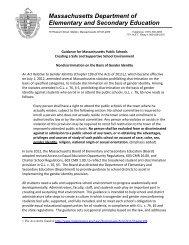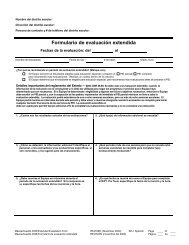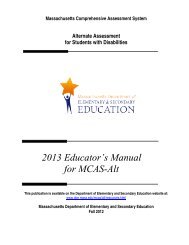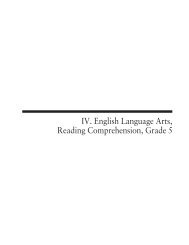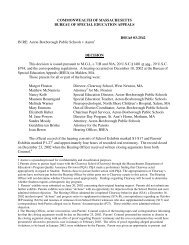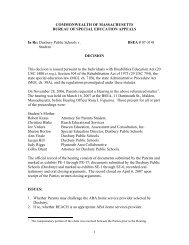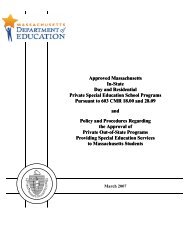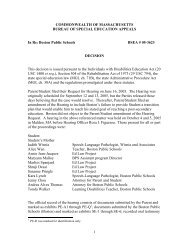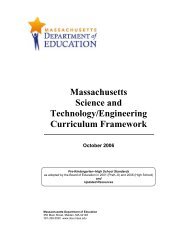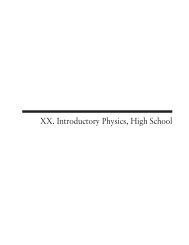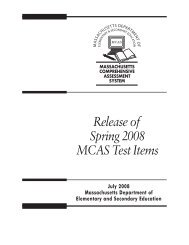Two Year Follow-up Review for Matthew J. Kuss Middle School
Two Year Follow-up Review for Matthew J. Kuss Middle School
Two Year Follow-up Review for Matthew J. Kuss Middle School
Create successful ePaper yourself
Turn your PDF publications into a flip-book with our unique Google optimized e-Paper software.
<strong>Follow</strong>-<strong>up</strong> <strong>Review</strong> Report, Spring 03 <strong>Kuss</strong> <strong>Middle</strong> <strong>School</strong>, Fall River, MA page 20<br />
the school to engage parents actively in the school’s improvement represents a missed<br />
opportunity, in the view of the Team, which may be a factor contributing to the school’s irregular<br />
per<strong>for</strong>mance on the MCAS tests over the past two years.<br />
KEY QUESTION 4: Is there currently a sound plan in place to guide continued<br />
improvement in student per<strong>for</strong>mance?<br />
As a result of their participation in the Per<strong>for</strong>mance Improvement Mapping (PIM) process<br />
sponsored by the MA Department of Education, a team of <strong>Kuss</strong> staff members has put together<br />
the beginnings of a new improvement plan <strong>for</strong> mathematics and a plan <strong>for</strong> English language arts<br />
that is greatly improved from the 2001- 2003 SIP. At the time of the <strong>Follow</strong>-<strong>up</strong> <strong>Review</strong>, the<br />
<strong>Kuss</strong> PIM team had not completed a few essential components of its plan, but appeared well on<br />
its way to completing the plan in the near future.<br />
The <strong>Kuss</strong> PIM team relied on MCAS and Terra Nova analyses to identify areas of greatest<br />
weakness in student knowledge and skill. Results of District benchmark tests were used where<br />
available to further refine the identification of learning gaps. In addition to aggregate scores and<br />
results disaggregated by student subgro<strong>up</strong>, the DOE provided <strong>Kuss</strong> planners with detailed item<br />
analyses, graphs of student responses by item difficulty and type, and comparisons of <strong>Kuss</strong><br />
responses with those of other students in the district and across the state.<br />
Similar to past planning ef<strong>for</strong>ts, the <strong>Kuss</strong> PIM team did not have reliable program<br />
implementation in<strong>for</strong>mation on which to base it planning decisions. As indicated in previous<br />
sections of this report, the school does not have systems in place to monitor the quality of<br />
implementation of its new math and literacy programs and has not been able to link changes in<br />
student per<strong>for</strong>mance with adjustments to its curriculum. Since the school relies primarily on<br />
yearly standardized assessments to judge the effectiveness of its work, <strong>Kuss</strong> teachers and<br />
administrators cannot determine with certainty which changes, if any, have had a positive impact<br />
on student achievement. Without accurate in<strong>for</strong>mation about instructional practices throughout<br />
the school, sorted by student subgro<strong>up</strong> and content area, the PIM team’s selection of strategies to<br />
improve student achievement is hampered.<br />
The PIM team’s analysis of the data available to it revealed weaknesses in the same general areas<br />
and standards as were identified <strong>for</strong> the earlier SIP, but the learning objectives in the PIM plan<br />
are much more precise. For example, where the original plan listed a general goal “to improve<br />
students’ independent reading and critical thinking skills,” the <strong>Kuss</strong> PIM plan lists seven specific<br />
student learning objectives, clearly describing where student learning is lacking (“All students<br />
will be able to cite specific examples from the selection to s<strong>up</strong>port their answers.”) The new set<br />
of learning objectives are easy to track by examining student work samples throughout the year,<br />
rather than relying on the belated results of standardized assessments to monitor progress. The<br />
<strong>Kuss</strong> PIM mathematics learning objectives are similarly specific in identifying observable and<br />
measurable learning tasks that are directly linked to evidence from previous assessment results.<br />
In the judgment of the <strong>Review</strong> Team, the <strong>Kuss</strong> PIM 2003-2004 <strong>School</strong> Improvement Plan has<br />
accurately identified gaps in student learning based on a careful and thorough analysis of student<br />
test results.<br />
Massachusetts Department of Education




